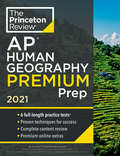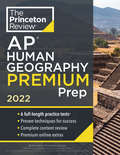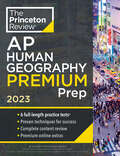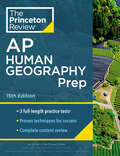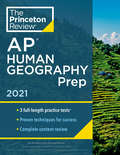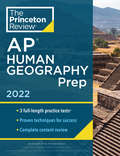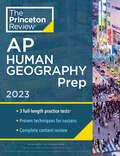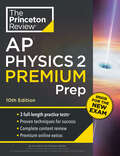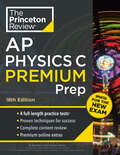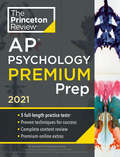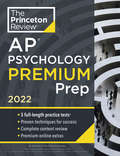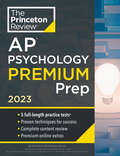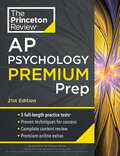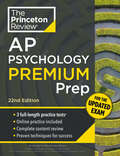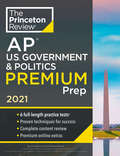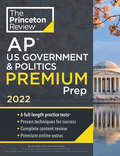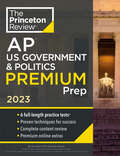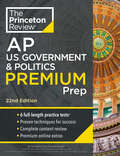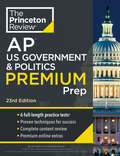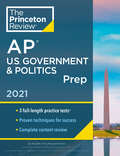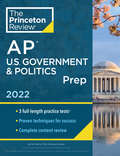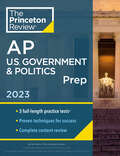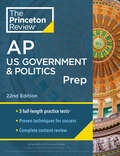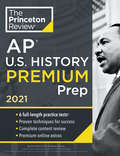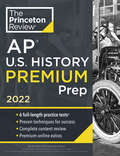- Table View
- List View
Princeton Review AP Human Geography Premium Prep, 2021: 6 Practice Tests + Complete Content Review + Strategies & Techniques (College Test Preparation)
by The Princeton ReviewPREMIUM PREP FOR A PERFECT 5, WITH THE MOST PRACTICE ON THE MARKET!Ace the 2021 AP Human Geography Exam with this Premium version of The Princeton Review's comprehensive study guide—including 6 full-length practice tests (more than any major competitor) with complete explanations, thorough content reviews, targeted strategies for every question type, and access to online extras.Techniques That Actually Work.• Tried-and-true strategies to help you avoid traps and beat the test• Tips for pacing yourself and guessing logically• Essential tactics to help you work smarter, not harderEverything You Need to Know to Help Achieve a High Score.• Detailed coverage of all test topics, including population and migration, cultural studies, political geography, urban geography, agriculture, and more• Updated to align with the latest College Board standards• Useful lists of key terms in every content review chapter• Access to study plans, helpful pre-college information, and more via your online Student ToolsPremium Practice for AP Excellence• 3 full-length practice tests in the book with detailed answer explanations• 3 full-length practice tests online with detailed answer explanations• Practice drills at the end of every content review chapter to test your understanding• Helpful maps and detailed charts illustrating trends, theories, and models
Princeton Review AP Human Geography Premium Prep, 2022: 6 Practice Tests + Complete Content Review + Strategies & Techniques (College Test Preparation)
by The Princeton ReviewPREMIUM PREP FOR A PERFECT 5, WITH THE MOST PRACTICE ON THE MARKET!Ace the 2022 AP Human Geography Exam with this Premium version of The Princeton Review's comprehensive study guide—including 6 full-length practice tests (more than any major competitor) with complete explanations, thorough content reviews, targeted strategies for every question type, and access to online extras.Techniques That Actually Work.• Tried-and-true strategies to help you avoid traps and beat the test• Tips for pacing yourself and guessing logically• Essential tactics to help you work smarter, not harderEverything You Need to Know to Help Achieve a High Score.• Fully aligned with the latest College Board standards for AP Human Geography• Detailed coverage of all test topics, including population and migration, cultural studies, political geography, urban geography, agriculture, and more• Useful lists of key terms in every content review chapter• Access to study plans, helpful pre-college information, and more via your online Student ToolsPremium Practice for AP Excellence• 6 full-length practice tests (3 in the book, 3 online) with detailed answer explanations• Practice drills at the end of every content review chapter to test your understanding• Helpful maps and detailed charts illustrating trends, theories, and models
Princeton Review AP Human Geography Premium Prep, 2023: 6 Practice Tests + Complete Content Review + Strategies & Techniques (College Test Preparation)
by The Princeton ReviewAce the 2023 AP Human Geography Exam with this Premium version of The Princeton Review's comprehensive study guide—including 6 full-length practice tests with complete explanations, thorough content reviews, targeted strategies for every question type, and access to online extras.Techniques That Actually Work• Tried-and-true strategies to help you avoid traps and beat the test• Tips for pacing yourself and guessing logically• Essential tactics to help you work smarter, not harderEverything You Need for a High Score• Fully aligned with the latest College Board standards for AP Human Geography• Detailed coverage of all test topics, including population and migration, cultural studies, political geography, urban geography, agriculture, and more• Useful lists of key terms in every content review chapter• Access to study plans, helpful pre-college information, and more via your online Student ToolsPremium Practice for AP Excellence• 6 full-length practice tests (3 in the book, 3 online) with detailed answer explanations• Practice drills at the end of every content review chapter to test your understanding• Helpful maps and detailed charts illustrating trends, theories, and models
Princeton Review AP Human Geography Prep, 15th Edition: 3 Practice Tests + Complete Content Review + Strategies & Techniques (College Test Preparation)
by The Princeton ReviewEVERYTHING YOU NEED TO HELP SCORE A PERFECT 5. Ace the AP Human Geography Exam with this comprehensive study guide—including 3 full-length practice tests with complete explanations, thorough content reviews, targeted strategies for every question type, and access to online extras.Techniques That Actually Work• Tried-and-true strategies to help you avoid traps and beat the test• Tips for pacing yourself and guessing logically• Essential tactics to help you work smarter, not harderEverything You Need for a High Score• Fully aligned with the latest College Board standards for AP Human Geography• Detailed coverage of all test topics, including population and migration, cultural studies, political geography, urban geography, agriculture, and more• Useful lists of key terms in every content review chapter• Access to study plans, helpful pre-college information, and more via your online Student ToolsPractice Your Way to Excellence• 3 full-length practice tests (2 in the book, 1 online) with complete answer explanations• Practice drills at the end of every content review chapter to test your understanding• Helpful maps and detailed charts illustrating trends, theories, and models
Princeton Review AP Human Geography Prep, 2021: 3 Practice Tests + Complete Content Review + Strategies & Techniques (College Test Preparation)
by The Princeton ReviewEVERYTHING YOU NEED TO HELP SCORE A PERFECT 5. Ace the 2021 AP Human Geography Exam with this comprehensive study guide—including 3 full-length practice tests with complete explanations, thorough content reviews, targeted strategies for every question type, and access to online extras.Techniques That Actually Work.• Tried-and-true strategies to help you avoid traps and beat the test• Tips for pacing yourself and guessing logically• Essential tactics to help you work smarter, not harderEverything You Need to Know to Help Achieve a High Score.• Detailed coverage of all test topics, including population and migration, cultural studies, political geography, urban geography, agriculture, and more• Updated to align with the latest College Board standards• Useful lists of key terms in every content review chapter• Access to study plans, helpful pre-college information, and more via your online Student ToolsPractice Your Way to Excellence.• 3 full-length practice tests (2 in the book, 1 online) with complete answer explanations• Practice drills at the end of every content review chapter to test your understanding• Helpful maps and detailed charts illustrating trends, theories, and models
Princeton Review AP Human Geography Prep, 2022: Practice Tests + Complete Content Review + Strategies & Techniques (College Test Preparation)
by The Princeton ReviewEVERYTHING YOU NEED TO HELP SCORE A PERFECT 5. Ace the 2022 AP Human Geography Exam with this comprehensive study guide—including 3 full-length practice tests with complete explanations, thorough content reviews, targeted strategies for every question type, and access to online extras.Techniques That Actually Work.• Tried-and-true strategies to help you avoid traps and beat the test• Tips for pacing yourself and guessing logically• Essential tactics to help you work smarter, not harderEverything You Need to Know to Help Achieve a High Score.• Fully aligned with the latest College Board standards for AP Human Geography• Detailed coverage of all test topics, including population and migration, cultural studies, political geography, urban geography, agriculture, and more• Useful lists of key terms in every content review chapter• Access to study plans, helpful pre-college information, and more via your online Student ToolsPractice Your Way to Excellence.• 3 full-length practice tests (2 in the book, 1 online) with complete answer explanations• Practice drills at the end of every content review chapter to test your understanding• Helpful maps and detailed charts illustrating trends, theories, and models
Princeton Review AP Human Geography Prep, 2023: 3 Practice Tests + Complete Content Review + Strategies & Techniques (College Test Preparation)
by The Princeton ReviewEVERYTHING YOU NEED TO HELP SCORE A PERFECT 5. Ace the 2023 AP Human Geography Exam with this comprehensive study guide—including 3 full-length practice tests with complete explanations, thorough content reviews, targeted strategies for every question type, and access to online extras. Techniques That Actually Work • Tried-and-true strategies to help you avoid traps and beat the test • Tips for pacing yourself and guessing logically • Essential tactics to help you work smarter, not harder Everything You Need for a High Score • Fully aligned with the latest College Board standards for AP Human Geography • Detailed coverage of all test topics, including population and migration, cultural studies, political geography, urban geography, agriculture, and more • Useful lists of key terms in every content review chapter • Access to study plans, helpful pre-college information, and more via your online Student Tools Practice Your Way to Excellence • 3 full-length practice tests (2 in the book, 1 online) with complete answer explanations • Practice drills at the end of every content review chapter to test your understanding • Helpful maps and detailed charts illustrating trends, theories, and models
Princeton Review AP Physics 2 Premium Prep, 10th Edition: 3 Practice Tests + Digital Practice Online + Content Review (College Test Preparation)
by The Princeton ReviewEVERYTHING YOU NEED TO HELP SCORE A PERFECT 5! Ace the NEWLY-UPDATED AP Physics 2 Exam with this comprehensive study guide—including 3 full-length practice tests (2 in the book, 1 online) with complete explanations, content reviews, exam strategies, and access to online extras.AP Physics 2 is getting an update! Starting with the Fall 2024 course and the May 2025 exam, students testing on this challenging topic will find both an expanded range of content and a revised exam format with new question types. This book addresses it all and helps you approach test day with confidence.Techniques That Actually Work• Tried-and-true strategies to avoid traps and beat the test• Tips for pacing yourself and guessing logically• Essential tactics to help you work smarter, not harderEverything You Need for a High Score• Fully updated to reflect the latest College Board standards for AP® Physics 2• Comprehensive coverage of thermodynamics, electrostatics, magnetic fields, electromagnetism, geometric and physical optics, and more• Tons of charts and figures to illustrate key concepts• Access to study plans, a handy list of equations and formulas, helpful pre-college information, and more via your online Student ToolsPractice Your Way to Excellence• 3 full-length practice tests (2 in the book, 1 online) with detailed answer explanations• Practice drills at the end of each content review chapter• Step-by-step walk-throughs of sample questions
Princeton Review AP Physics C Premium Prep, 18th Edition: 4 Practice Tests + Digital Practice Online + Content Review (College Test Preparation)
by The Princeton ReviewEVERYTHING YOU NEED TO HELP SCORE A PERFECT 5! Ace the UPDATED AP Physics C Exam with this comprehensive study guide—including 4 full-length practice tests with complete answer explanations, content reviews, exam strategies, and bonus online extras.AP Physics C is getting an update! Starting with the Fall 2024 course and the May 2025 exam, students testing on this challenging topic will face a longer test with more questions, including four brand-new types of free response questions (FRQs). This book addresses it all and helps you approach test day with confidence.Techniques That Actually Work• Tried-and-true strategies to help you avoid traps and beat the test• Tips for pacing yourself and guessing logically• Essential tactics to help you work smarter, not harderEverything You Need for a High Score• Fully updated to reflect the latest College Board standards for AP® Physics C• Comprehensive content review for both Mechanics and Electricity & Magnetism• Tons of charts and figures to illustrate concepts• Access to study plans, a handy list of equations and formulas, helpful pre-college information, and more via your online Student ToolsPractice Your Way to Excellence• 4 full-length practice tests (2 in the book, 2 online) with detailed answer explanations• Practice drills at the end of each content review chapter• Step-by-step walk-throughs of sample Mechanics and Electricity & Magnetism exam questions
Princeton Review AP Psychology Premium Prep, 2021: 5 Practice Tests + Complete Content Review + Strategies & Techniques (College Test Preparation)
by The Princeton ReviewPREMIUM PREP FOR A PERFECT 5—now with 150% more practice than previous editions!Ace the 2021 AP Psychology Exam with this Premium version of the Princeton Review's comprehensive study guide. Includes 5 full-length practice tests with complete explanations, thorough content reviews, targeted strategies for every section of the exam, and access to online extras.Techniques That Actually Work.• Tried-and-true strategies to help you avoid traps and beat the test• Tips for pacing yourself and guessing logically• Essential tactics to help you work smarter, not harderEverything You Need to Know to Help Achieve a High Score.• Comprehensive content review for all test topics• Up-to-date information on the 2021 course & exam• Access to study plans, a handy list of key terms, helpful pre-college information, and more via your online Student ToolsPractice Your Way to Excellence.• 5 full-length practice tests (4 in the book, 1 online) with complete answer explanations• Practice drills at the end of each content review chapter• Step-by-step explanations of sample questions to help you create your personal pacing strategy• Online study guides to strategically plan out your AP Psychology prep
Princeton Review AP Psychology Premium Prep, 2022: 5 Practice Tests + Complete Content Review + Strategies & Techniques (College Test Preparation)
by The Princeton ReviewPREMIUM PREP FOR A PERFECT 5! Ace the 2022 AP Psychology Exam with this Premium version of the Princeton Review's comprehensive study guide. Includes 5 full-length practice tests , thorough content reviews, targeted strategies for every section of the exam, and access to online extras. Techniques That Actually Work. • Tried-and-true strategies to help you avoid traps and beat the test • Tips for pacing yourself and guessing logically • Essential tactics to help you work smarter, not harder Everything You Need to Know to Help Achieve a High Score. • Fully aligned with the latest College Board standards for AP® Psychology • Comprehensive content review for all test topics • Access to study plans, a handy list of key terms, helpful pre-college information, and more via your online Student Tools Practice Your Way to Excellence. • 5 full-length practice tests (4 in the book, 1 online) with complete answer explanations • Practice drills at the end of each content review chapter • Step-by-step explanations of sample questions to help you create your personal pacing strategy • Online study guides to strategically plan out your AP Psychology prep
Princeton Review AP Psychology Premium Prep, 2023: 5 Practice Tests + Complete Content Review + Strategies & Techniques (College Test Preparation)
by The Princeton ReviewPREMIUM PREP FOR A PERFECT 5! Ace the 2023 AP Psychology Exam with this Premium version of the Princeton Review's comprehensive study guide. Includes 5 full-length practice tests , thorough content reviews, targeted strategies for every section of the exam, and access to online extras. Techniques That Actually Work • Tried-and-true strategies to help you avoid traps and beat the test • Tips for pacing yourself and guessing logically • Essential tactics to help you work smarter, not harder Everything You Need for a High Score • Fully aligned with the latest College Board standards for AP® Psychology • Comprehensive content review for all test topics • Access to study plans, a handy list of key terms, helpful pre-college information, and more via your online Student Tools Practice Your Way to Excellence • 5 full-length practice tests (4 in the book, 1 online) with complete answer explanations • Practice drills at the end of each content review chapter • Step-by-step explanations of sample questions to help you create your personal pacing strategy • Online study guides to strategically plan out your AP Psychology prep
Princeton Review AP Psychology Premium Prep, 21st Edition: 5 Practice Tests + Complete Content Review + Strategies & Techniques (College Test Preparation)
by The Princeton ReviewPREMIUM PREP FOR A PERFECT 5! Ace the AP Psychology Exam with this Premium version of the Princeton Review's comprehensive study guide. Includes 5 full-length practice tests, thorough content reviews, targeted strategies for every section of the exam, and access to online extras.Techniques That Actually Work• Tried-and-true strategies to help you avoid traps and beat the test• Tips for pacing yourself and guessing logically• Essential tactics to help you work smarter, not harderEverything You Need for a High Score• Fully aligned with the latest College Board standards for AP® Psychology• Comprehensive content review for all test topics• Access to study plans, a handy list of key terms, helpful pre-college information, and more via your online Student ToolsPractice Your Way to Excellence• 5 full-length practice tests (4 in the book, 1 online) with complete answer explanations• Practice drills at the end of each content review chapter• Step-by-step explanations of sample questions to help you create your personal pacing strategy• Online study guides to strategically plan out your AP Psychology prep
Princeton Review AP Psychology Premium Prep, 22nd Edition: For the NEW 2025 Exam: 3 Practice Tests + Digital Practice + Content Review (College Test Preparation)
by The Princeton ReviewTHE AP PSYCHOLOGY TEST IS CHANGING! Get all the help you need to ace the NEW Digital AP Psych exam with The Princeton Review's comprehensive study guide—including 3 practice tests with answer explanations, timed online practice, and thorough content reviews.Everything You Need for a High Score• Fully updated for the NEW Digital College Board AP® Psychology course standards• Comprehensive content review for all test topics• Access to study plans, a handy list of key terms, helpful pre-college information, and more via your online Student ToolsPremium Practice for AP Excellence• 3 full-length practice tests (2 in the book, 1 online) with complete answer explanations, all revised for the May 2025 exam changes• Practice drills at the end of each content review chapter• Step-by-step explanations of sample questions • Online study guidesTechniques That Actually Work• Tried-and-true strategies to help you avoid traps and beat the test• Tips for pacing yourself and guessing logically• Essential tactics to help you work smarter, not harder
Princeton Review AP U.S. Government & Politics Premium Prep, 2021: 6 Practice Tests + Complete Content Review + Strategies & Techniques (College Test Preparation)
by The Princeton ReviewPREMIUM PRACTICE FOR A PERFECT 5—WITH THE MOST PRACTICE ON THE MARKET!Ace the 2021 AP U.S. Government & Politics Exam with this Premium version of The Princeton Review's comprehensive study guide. Includes 6 full-length practice exams (more than any other major competitor), plus thorough content reviews, targeted test strategies, and access to online extras.Techniques That Actually Work.• Tried-and-true strategies to help you avoid traps and beat the test• Tips for pacing yourself and guessing logically• Essential tactics to help you work smarter, not harderEverything You Need to Know to Help Achieve a High Score.• Content review for all test topics, with a quick-reference glossary for the most important dates, cases, and information• Updated to align with the latest College Board standards• Access to handy study guides, printable resources, helpful pre-college information, and more via your online Student ToolsPremium Practice for AP Excellence.• 6 full-length practice tests (4 in the book, 2 online) with detailed answer explanations• Helpful comprehension drills at the end of each content review chapter• Strategies for all multiple-choice question types
Princeton Review AP U.S. Government & Politics Premium Prep, 2022: 6 Practice Tests + Complete Content Review + Strategies & Techniques (College Test Preparation)
by The Princeton ReviewPREMIUM PRACTICE FOR A PERFECT 5—WITH THE MOST PRACTICE ON THE MARKET! Ace the 2022 AP U.S. Government & Politics Exam with this Premium version of The Princeton Review's comprehensive study guide. Includes 6 full-length practice exams (more than any other major competitor), plus thorough content reviews, targeted test strategies, and access to online extras. Techniques That Actually Work. • Tried-and-true strategies to help you avoid traps and beat the test • Tips for pacing yourself and guessing logically • Essential tactics to help you work smarter, not harder Everything You Need to Know to Help Achieve a High Score. • Fully aligned with the latest College Board standards for AP® U.S. Government & Politics• Content review for all test topics, with a quick-reference glossary for the most important dates, cases, and information • Access to handy study guides, printable resources, helpful pre-college information, and more via your online Student Tools Premium Practice for AP Excellence. • 6 full-length practice tests (4 in the book, 2 online) with detailed answer explanations • Helpful comprehension drills at the end of each content review chapter • Strategies for all multiple-choice question types
Princeton Review AP U.S. Government & Politics Premium Prep, 2023: 6 Practice Tests + Complete Content Review + Strategies & Techniques (College Test Preparation)
by The Princeton ReviewPREMIUM PRACTICE FOR A PERFECT 5—WITH THE MOST PRACTICE ON THE MARKET! Ace the 2023 AP U.S. Government & Politics Exam with this Premium version of The Princeton Review's comprehensive study guide. Includes 6 full-length practice exams, plus thorough content reviews, targeted test strategies, and access to online extras. Techniques That Actually Work • Tried-and-true strategies to help you avoid traps and beat the test • Tips for pacing yourself and guessing logically • Essential tactics to help you work smarter, not harder Everything You Need for a High Score • Fully aligned with the latest College Board standards for AP® U.S. Government & Politics • Content review for all test topics, with a quick-reference glossary for the most important dates, cases, and information • Access to handy study guides, printable resources, helpful pre-college information, and more via your online Student Tools Premium Practice for AP Excellence • 6 full-length practice tests (4 in the book, 2 online) with detailed answer explanations • Helpful comprehension drills at the end of each content review chapter • Strategies for all multiple-choice question types
Princeton Review AP U.S. Government & Politics Premium Prep, 22nd Edition: 6 Practice Tests + Complete Content Review + Strategies & Techniques (College Test Preparation)
by The Princeton ReviewPREMIUM PRACTICE FOR A PERFECT 5—WITH THE MOST PRACTICE ON THE MARKET!Ace the AP U.S. Government & Politics Exam with this Premium version of The Princeton Review's comprehensive study guide. Includes 6 full-length practice exams, plus thorough content reviews, targeted test strategies, and access to online extras.Techniques That Actually Work• Tried-and-true strategies to help you avoid traps and beat the test• Tips for pacing yourself and guessing logically• Essential tactics to help you work smarter, not harderEverything You Need for a High Score• Fully aligned with the latest College Board standards for AP® U.S. Government & Politics• Content review for all test topics, with a quick-reference glossary for the most important dates, cases, and information• Access to handy study guides, printable resources, helpful pre-college information, and more via your online Student ToolsPremium Practice for AP Excellence• 6 full-length practice tests (4 in the book, 2 online) with detailed answer explanations• Helpful comprehension drills at the end of each content review chapter• Strategies for all multiple-choice question types
Princeton Review AP U.S. Government & Politics Premium Prep, 23rd Edition: 6 Practice Tests + Digital Practice Online + Content Review (College Test Preparation)
by The Princeton ReviewPREMIUM PRACTICE FOR A PERFECT 5—WITH THE MOST PRACTICE ON THE MARKET! Ace the AP U.S. Government & Politics Exam with The Princeton Review's comprehensive study guide. Includes 6 full-length practice exams, plus thorough content reviews, targeted test strategies, and access to online extras.Techniques That Actually Work• Tried-and-true strategies to help you avoid traps and beat the test• Tips for pacing yourself and guessing logically• Essential tactics to help you work smarter, not harderEverything You Need for a High Score• Fully aligned with the latest College Board standards for AP® U.S. Government & Politics• Content review for all test topics, with a quick-reference glossary for the most important dates, cases, and information• Online digital flashcards to review core content• Access to handy study guides, printable resources, helpful pre-college information, and more via your online Student ToolsPremium Practice for AP Excellence• 6 full-length practice tests (4 in the book, 2 online) with detailed answer explanations• Helpful comprehension drills at the end of each content review chapter• Strategies for all multiple-choice question types
Princeton Review AP U.S. Government & Politics Prep, 2021: 3 Practice Tests + Complete Content Review + Strategies & Techniques (College Test Preparation)
by The Princeton ReviewEVERYTHING YOU NEED TO HELP SCORE A PERFECT 5—now with 50% more practice than previous editions!Ace the AP U.S. Government & Politics Exam with this comprehensive study guide, including 3 full-length practice tests with answer explanations, content reviews, targeted strategies for every question type, and access to free online bonus content. Techniques That Actually Work.• Tried-and-true strategies to help you avoid traps and beat the test• Tips for pacing yourself and guessing logically• Essential tactics to help you work smarter, not harderEverything You Need to Know to Help Achieve a High Score.• Content review for all test topics, with a quick-reference glossary for the most important dates, cases, and information• Updated to align with the latest College Board standards• Access to handy study guides, printable resources, helpful pre-college information, and more via your online Student ToolsPractice Your Way to Excellence.• 3 full-length practice tests (2 in the book, 1 online) with detailed answer explanations• Helpful comprehension drills at the end of each content review chapter• Strategies for all multiple-choice question types
Princeton Review AP U.S. Government & Politics Prep, 2022: Practice Tests + Complete Content Review + Strategies & Techniques (College Test Preparation)
by The Princeton ReviewEVERYTHING YOU NEED TO HELP SCORE A PERFECT 5! Ace the AP U.S. Government & Politics Exam with this comprehensive study guide, including 3 full-length practice tests, content reviews, targeted strategies for every question type, and access to free online bonus content. Techniques That Actually Work. • Tried-and-true strategies to help you avoid traps and beat the test • Tips for pacing yourself and guessing logically • Essential tactics to help you work smarter, not harder Everything You Need to Know to Help Achieve a High Score. • Fully aligned with the latest College Board standards for AP® U.S.Government & Politics• Content review for all test topics, with a quick-reference glossary for the most important dates, cases, and information • Access to handy study guides, printable resources, helpful pre-college information, and more via your online Student Tools Practice Your Way to Excellence. • 3 full-length practice tests (2 in the book, 1 online) with detailed answer explanations • Helpful comprehension drills at the end of each content review chapter • Strategies for all multiple-choice question types
Princeton Review AP U.S. Government & Politics Prep, 2023: 3 Practice Tests + Complete Content Review + Strategies & Techniques (College Test Preparation)
by The Princeton ReviewEVERYTHING YOU NEED TO HELP SCORE A PERFECT 5! Ace the AP U.S. Government & Politics Exam with this comprehensive study guide, including 3 full-length practice tests, content reviews, targeted strategies for every question type, and access to free online bonus content. Techniques That Actually Work • Tried-and-true strategies to help you avoid traps and beat the test • Tips for pacing yourself and guessing logically • Essential tactics to help you work smarter, not harder Everything You Need for a High Score • Fully aligned with the latest College Board standards for AP® U.S.Government & Politics • Content review for all test topics, with a quick-reference glossary for the most important dates, cases, and information • Access to handy study guides, printable resources, helpful pre-college information, and more via your online Student Tools Practice Your Way to Excellence • 3 full-length practice tests (2 in the book, 1 online) with detailed answer explanations • Helpful comprehension drills at the end of each content review chapter • Strategies for all multiple-choice question types
Princeton Review AP U.S. Government & Politics Prep, 22nd Edition: 3 Practice Tests + Complete Content Review + Strategies & Techniques (College Test Preparation)
by The Princeton ReviewEVERYTHING YOU NEED TO HELP SCORE A PERFECT 5! Ace the AP U.S. Government & Politics Exam with this comprehensive study guide, including 3 full-length practice tests, content reviews, targeted strategies for every question type, and access to free online bonus content.Techniques That Actually Work• Tried-and-true strategies to help you avoid traps and beat the test• Tips for pacing yourself and guessing logically• Essential tactics to help you work smarter, not harderEverything You Need for a High Score• Fully aligned with the latest College Board standards for AP® U.S.Government & Politics• Content review for all test topics, with a quick-reference glossary for the most important dates, cases, and information• Access to handy study guides, printable resources, helpful pre-college information, and more via your online Student ToolsPractice Your Way to Excellence• 3 full-length practice tests (2 in the book, 1 online) with detailed answer explanations• Helpful comprehension drills at the end of each content review chapter• Strategies for all multiple-choice question types
Princeton Review AP U.S. History Premium Prep, 2021: 6 Practice Tests + Complete Content Review + Strategies & Techniques (College Test Preparation)
by The Princeton ReviewPREP FOR A PERFECT 5 WITH THE BESTSELLING AP U.S. HISTORY BOOK ON THE MARKET!Ace the 2021 AP U.S. History Exam with this Premium version of The Princeton Review's comprehensive study guide. Includes 6 full-length practice exams, thorough content reviews, targeted test strategies, and access to online extras.Techniques That Actually Work.• Tried-and-true strategies to help you avoid traps and beat the test• Tips for pacing yourself and guessing logically• Essential tactics to help you work smarter, not harderEverything You Need to Know to Help Achieve a High Score.• Detailed coverage of the short-answer and source-based multiple-choice questions• In-depth guidance on the document-based and long essay questions• Updated to align with the latest College Board standards• Access to study plans, a handy list of key terms and concepts, helpful pre-college information, and more via your online Student ToolsPremium Practice for AP Excellence.• 6 full-length practice tests (4 in the book, 2 online) with complete answer explanations• End-of-chapter review questions to test your retention of the material• Pacing drills to help you maximize points
Princeton Review AP U.S. History Premium Prep, 2022: 6 Practice Tests + Complete Content Review + Strategies & Techniques (College Test Preparation)
by The Princeton ReviewPREP FOR A PERFECT 5 WITH THE BESTSELLING AP U.S. HISTORY BOOK ON THE MARKET! Ace the 2022 AP U.S. History Exam with this Premium version of The Princeton Review's comprehensive study guide. Includes 6 full-length practice exams, thorough content reviews, targeted test strategies, and access to online extras. Techniques That Actually Work. • Tried-and-true strategies to help you avoid traps and beat the test • Tips for pacing yourself and guessing logically • Essential tactics to help you work smarter, not harder Everything You Need to Know to Help Achieve a High Score. • Fully aligned with the latest College Board standards for AP® U.S. History • Detailed coverage of the short-answer and source-based multiple-choice questions • In-depth guidance on both the document-based and the long essay questions • Access to study plans, a handy list of key terms and concepts, helpful pre-college information, and more via your online Student Tools Premium Practice for AP Excellence. • 6 full-length practice tests (4 in the book, 2 online) with complete answer explanations • End-of-chapter review questions to test your retention of the material • Pacing drills to help you maximize points
